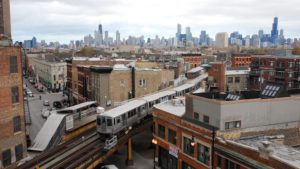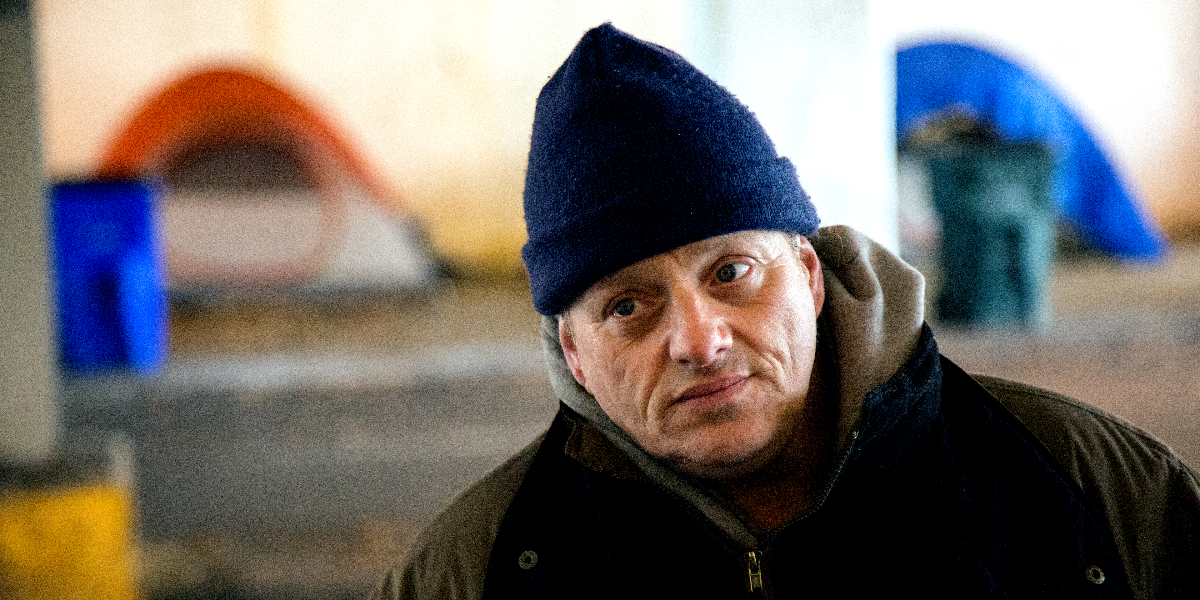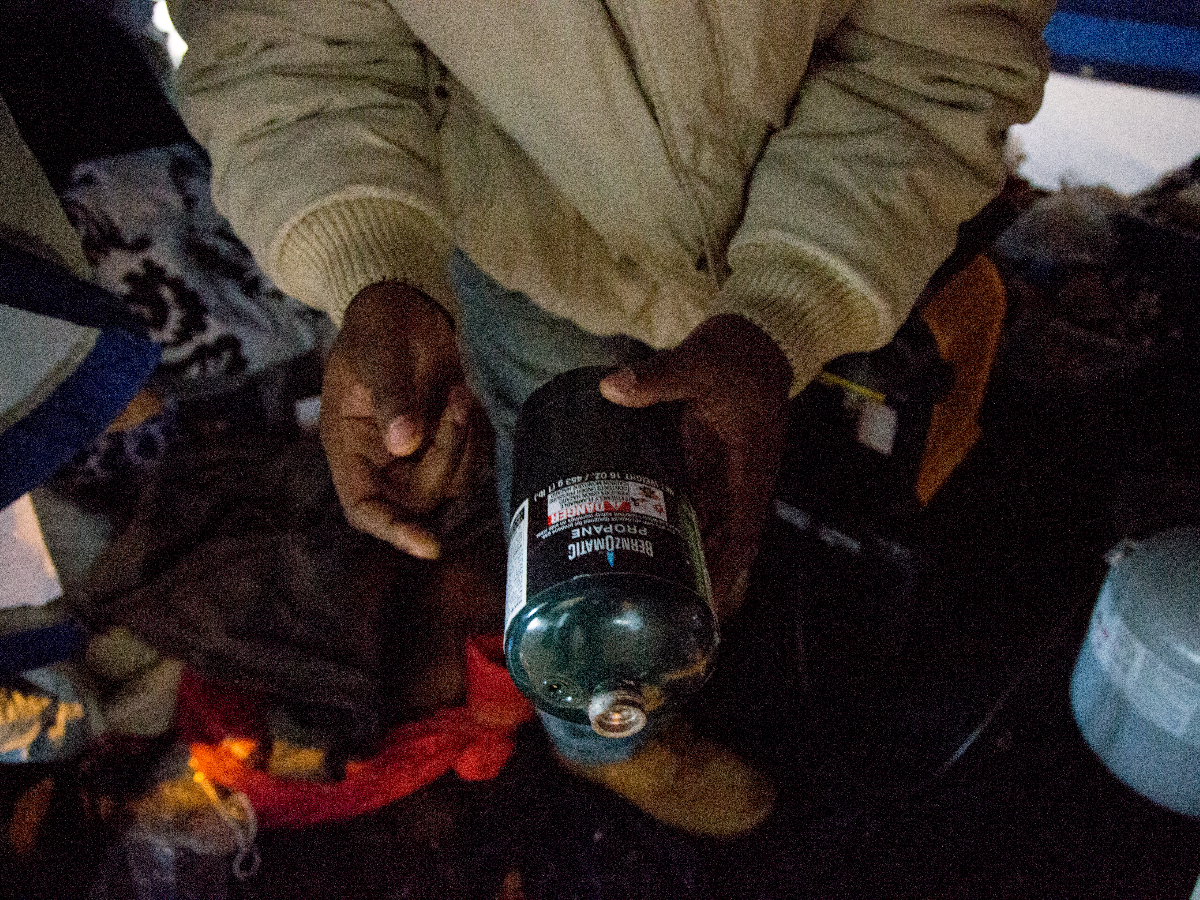
Click image for an interactive experience
By Odette Yousef
Jake Riley has lived in Chicago for seven winters, and every year, come Halloween time, he notices something. “Nobody is outside, including homeless people,” says the Edgewater resident.
So he came to Curious City with this question: “Where do all the homeless people in Chicago go during the wintertime?”
Riley’s guess is that in the winter, people stay in homeless shelters.
“But then my question would be, well, why can’t those shelters help people all the time?” he says.
For help with Jake’s question, we turned to someone who was homeless in the city for three years. Fifty-nine-year-old Bryant Cunningham used to have a job and his own apartment, but he lost both around 2013 after his health took a turn for the worse and left him unable to work.
“I had — in a 3-month period — four heart attacks,” says Cunningham. “When I got out, it was a little hard to get back in the saddle. I got behind in the bills.”
One of those bills was his rent, and Cunningham lost his apartment.
Cunningham can’t speak to every single type of place that homeless people stay in the winter. The options are numerous, and everyone makes decisions based on personal circumstances.
But after talking with Cunningham, homeless advocates and social service providers, we can profile the most common places homeless Chicagoans stay during the winter. Each, it turns out, offers pros and cons when it comes to comfort, convenience, safety and dignity.
“Doubling up”
The first thing that Cunningham did after he lost his apartment was move in with his daughter and son-in-law. “Doubling up,” as it’s often called, affords the comfort of being indoors with familiar people. And, according to one expert, this option may be more available in the cold season than in warm ones.
“When it’s colder there might be more willingness … to open [a home] up to someone who typically might be on the streets,” says Doug Schenkelberg, executive director of the Chicago Coalition for the Homeless.
But prolonged living in close quarters can lead to tension. That’s what happened with Cunningham, who says it became difficult to live under the rules of his relatives.
For some, tolerance for these potentially awkward situations or strained relations may be higher when it’s freezing outside and they lack alternatives. But when the weather warms, some people may prefer to leave for other options.
As for Cunningham, he eventually decided he didn’t want to risk damaging his relationship with his daughter by staying too long. “After about a year or so, I said OK, before I get to a point where we get into it, because I love my daughter profusely, I said I’m just going to go head on.”

Bryant Cunningham, a former bus driver, lived without a home on-and-off for three years, after a series of heart attacks left him unable to work. (WBEZ/Maggie Sivit)
The Chicago Transit Authority ‘L’
After he left his daughter’s place, Cunningham tried living with a friend, but left after tensions arose there, too. To stay out of the cold, Cunningham spent a couple of weeks riding the CTA Red and Blue Lines at nights, from about 11:30 p.m. to 7:30 a.m.
He says that riding the ‘L’ through the night meant having to get off and re-board over and over again. The constant on-and-off also meant that a night on the trains did not make for a proper night’s sleep. Cunningham says, at best, he only caught about 45 minutes to an hour of rest at a time.
Cunningham adds that CTA personnel go after people who appear to be staying on the trains all night.
“It’s just like a game of checkers,” he says. “You never want to get to the very end of the line. [You want to get off] either one or two stops before the end.”

Cunningham says that when he slept on the ‘L’ all night, he had to look out for security guards. (WBEZ/Maggie Sivit)
In addition to providing an indoor, warm space during cold nights, the presence of other people on the ‘L’ can provide a measure of security.
But in the deepest hours of the night, when few people are riding the train, Cunningham says he worried about his safety and protecting his personal belongings. “If you sleep, make sure you have your back to the side seats at the furthest end in the corner with your bag covered, and your hands tucked over your bag,” he advises. “So if they had to go in your bag they have to tug it and then they will wake you up.”
Single Room Occupancy Hotels
Single room occupancy hotels offer room rentals for a month at a time. A few SROs in Chicago offer overnight or weekly rates, as well, though available units in these buildings can be hard to get. Monthly rates often fall between $350 to $800, and daily rates hover around $50. SROs often only rent to single individuals; they’re rarely options for people with partners or families.
Cunningham only stayed once at a SRO hotel. He mostly recalls the discomfort of having to go up and down stairs with his bad knees, because the building lacked an elevator. Some SROs are old and poorly-maintained, leading to complaints of crumbling infrastructure and bedbugs. Still, depending on one’s income status, unit availability and temperatures outside, SROs may be an acceptable option in the winter.
But it’s an option that may be declining. In recent years, several SROs in gentrifying Chicago neighborhoods have changed ownership and been converted to mostly market-rate housing. In other cases, community groups purchased an SRO. Though the groups are often committed to preserving affordable housing, the rehabs sometimes reduced the overall number of available units.
Public libraries
In addition to strategizing where to spend his nights, Cunningham also had to figure out where to go to stay warm during the daytime. Even if he happened to be staying at a shelter, it often didn’t allow guests to stay indoors between wake-up time and evening curfew. He says it was a challenge to find places that he could, as he put it, “kill the hours” without looking conspicuous or getting kicked out.

To stay warm during the daytime, Cunningham spent time at the Harold Washington Library, reading books and attending cultural events. (WBEZ/Maggie Sivit)
Cunningham’s favorite place to spend the day was the Harold Washington Library, and he spent a lot of time there. “From 9:30 [a.m.] to 9 o’clock [p.m.], Monday through Friday,” he says. And sometimes weekends too.
His favorite floors were where he could find instructional books on drawing cartoons, and catch occasional guest lectures and cultural performances. The library also offered Cunningham internet access on public computers, allowing him to catch up on current events and find information about public benefits he needed.
But libraries can also be unfriendly to homeless people. Cunningham says homeless people are often kicked out if they are found to be sleeping, so it was important to know a few tricks.
“You put the book (up) like you’re reading. … Or, you wear sunglasses while you’re reading,” he says. “[You] just have to make sure that the book is not upside down when you fall asleep.”
Stores, restaurants, etc.
Restaurants, coffee shops and stores also offer a warm place to duck into, especially on bitterly cold nights when libraries are mostly closed.
At some private establishments, Cunningham says staff are not welcoming to homeless people or anyone who appears to be settling in for a prolonged stay. Over time, Cunningham developed a detailed mental map of which restaurants and coffee shops were hospitable to homeless people, and would allow them to sit and nurse a coffee for hours at a time.
“McDonalds … Burger King,” he rattles off. “There’s a restaurant on Canal and Roosevelt called the White Palace. It’s been there a lot of years, and it’s open 24 hours.”
One of Cunningham’s frequent places was the Dunkin Donuts kitty-corner from the Harold Washington Library, where he developed an early morning routine. “Coffee, couple wraps, corner seat, and eat very, very slowly,” says Cunningham. He often sat at a table tucked way in the back where he was least likely to be disturbed or noticed.

On especially cold days, Cunningham would frequent the Dunkin Donuts near State and Van Buren to warm up with a hot cup of coffee. (WBEZ/Maggie Sivit)
However, Cunningham says he would only try this option if he felt his hygiene was up to par; he didn’t want attention from the staff or other patrons. And, of course, Cunningham notes that restaurants and coffee shops were only an option when he could spare a couple of dollars to buy a coffee, which he didn’t always have.
City warming centers
On the coldest of days, when temperatures fall below 32 degrees Fahrenheit, the City of Chicago allows people to visit its six warming centers. Most are open between 9 a.m. and 5 p.m. on weekdays. Chicago police stations and hospitals also allow individuals to sit in lobbies or waiting rooms. In general, these facilities will call a mobile van outreach program to pick up and transport people to homeless shelters to stay overnight.
Cunningham says the wait for the outreach van can be long. He recalled going to the Grand Crossing Police Station near 71st Street and South Cottage Grove Avenue. Staff called the mobile outreach van to pick him up and take him to a shelter. “I was sitting in the lobby, hugging a heater from 8 p.m.‘til about 3 or 4 in the morning,” he remembers. “And I just got tired and said, ‘Well, look, I’m going to go back to the ‘L’ because this is just madness.’”
Tent cities
Of course, some people manage to live outside even through cold winters. Cunningham didn’t try this.
“I don’t do outside, and I don’t do the camping thing,” he says.
Constant exposure to cold weather, uncertainty about one’s own safety and the security of one’s personal belongings can take a mental and physical toll. But depending on one’s health and equipment, this option may be preferable to others.
So-called “tent cities,” where homeless people form encampments under highways or in parks, have become increasingly visible in Chicago during recent years. For many who choose this living arrangement, it offers a deep sense of community that other options lack. They share resources, donations and help to protect each other against outsiders or the elements. Many people who live outdoors also say it offers them complete autonomy over their lifestyle and schedule, which they would lose if they were to go to a homeless shelter.
Shelters
Shelters are perhaps what most people, including our question asker, think of when they consider where someone without a home might stay.
Cunningham preferred to stay in shelters during the winter when he lacked other indoor options. He says shelters offered him a better sleep than CTA trains.
“You got your mats, your sheets, your blankets,” he explains.

Homeless shelters provide people food and a place to sleep. However, many choose to leave once the weather gets warm. (WBEZ/Paula Friedrich)
According to the U.S. Department of Housing and Urban Development, Chicago had 5,469 shelter beds available year-round in 2016. In general, that’s enough shelter beds to meet demand.
But on the coldest nights, the shelter system in Chicago does expand capacity. Lydia Stazen Michael, Vice President of Communications at All Chicago, says that on frigid nights, capacity may increase by 500 hundred spaces, allowing people to stay in hallways, or in shelter cafeterias where tables are cleared away to open floor space.
“It’s not great space,” she explains. “It’s like mats on the floor.” She says they do it because they won’t turn people away when it is dangerously cold outside.
Let’s return to the second part of Jake’s question: If shelters in Chicago have this expanded capacity in the winter, why don’t they house homeless people year round?
“The demand just goes down in the warmer weather,” says Stazen Michael. In other words, homeless people opt to go elsewhere when the weather gets warmer, perhaps because shelters can have so many downsides.
Cunningham says one of those downsides involves restrictions on where he and others could be during the daytime. At one shelter at which Cunningham stayed, he says staff were concerned that neighbors would complain about the shelter becoming a neighborhood nuisance if people loitered close by.
“They didn’t like you hanging in the two-block radius where the shelters and stuff were,” he says. “So you had to move around.”
Another common restriction at shelters is curfews. If an individual doesn’t make it back to the shelter by, say, 6:45 p.m., he or she may lose a spot. Additionally, several places have sobriety rules, requiring guests to stay clean during their time at the shelter.
Cunningham says that at one privately-run shelter, he was uncomfortable with a requirement to participate in religious activities in order to receive meals; “If you didn’t participate in sermons … they locked the door until after dinner.”
Many homeless people report of bed bugs at some shelters. They also fear having their personal possessions stolen.
The most common concern is that some shelters feel chaotic and unsafe. They can be like tinder boxes: communal living arrangements for groups of people who sometimes are dealing with major life stressors such as drug dependency and mental health challenges — in addition to unstable housing. One homeless services worker says that, in the worst cases, there are instances of physical fights and sexual abuse.
So to answer Jakes question: Shelters can be rough places to stay, and while many people use them to escape low temperatures in the winter, they choose to leave once the weather turns milder. Simply expanding capacity year-round would not necessarily solve homelessness in Chicago.
For Cunningham, the answer to homelessness was income. After years of waiting to receive federal disability benefits, he finally started getting those checks late last year. With that income, he qualified for a two-year subsidized housing program in a South Shore neighborhood. With a stable roof over his head, Cunningham looks forward to starting a job training program soon and working.
Cunningham says the key to finding a solution is to know that each person is unique.
“We’re all homeless for different reasons. Some have medical reasons, mental reasons,” he says. “So, there’s really no blanket answer to fix it without finding each individual that’s homeless, figure out how he or she got that way, and that’s about the best answer I can give you.”
More about our questioner

Courtesy of Jake Riley
Jake Riley is a buyer for a lighting company in Chicago’s River North neighborhood. He moved to Chicago from Nashville, Tennessee, seven years ago and lives in the Edgewater neighborhood.
“I live right next to the Red Line, the Thorndale station,” he says, explaining that most of his observations about the city come when he’s getting around on foot or by public transit.
Now that he’s heard about Cunningham’s experiences navigating winters without a home, Riley says he appreciates the reminder that not all homeless people are the same.
“It’s easy to not think like that, (and to think) that everyone is in the same boat and there’s a solution for all,” he says, “and there’s not.”



















